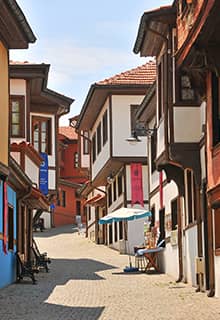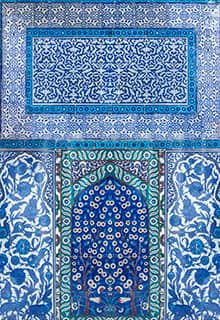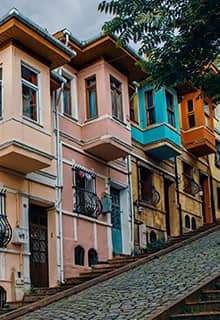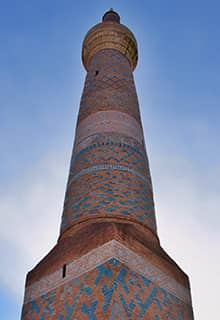

architectural designs & techniques
in Türkiye
Kündekari
This style first emerged in the 12th century along with the Seljuk Turks and was later extensively used by the Ottomans. Kündekari is a sophisticated wood marquetry technique that has a history of more than 800 years. Historically Kündekari was used in mosques, on doors, furniture, window shutters or cupboard doors, to ornament interiors but the technique is also celebrated today thanks to its durability. Without the use of any glue or nails, pieces of octagonal, hexagonal, crescent, rectangular and triangular geometric blocks and keel bars are interlocked together creating a whole structure, which is exceptionally hard-wearing. The finest examples of Kündekari can be enjoyed in various Seljuk period mosques, such as the Aladdin Mosque in Konya, and the Ulu Mosques of Birgi, Aksaray, Malatya and Siirt.
Traditional Joinery in Architecture
Wooden architecture is common in northern Türkiye where wood is abundant. Although there are many techniques, ‘çantı’ is one of the oldest, even ancient construction methods, in which timber structures were constructed without the use of any nails.
Cumba
One of the most characteristic features of traditional Turkish houses is the ‘cumba’, a projecting window or balcony from the upper storeys. This feature gives homes a unique relationship with the streets below because of the overhang onto the shared space below. Because the predominant religious culture valued privacy and this consideration was an influence on the traditional architectural styles, the cumba become an important aspect of daily life not only for women who generally stayed in their homes but also to everyone in the household because the overhanging window or balcony, gave those indoors the opportunity to observe the street, without being seen by the passers-by. In some places, baskets were lowered from the aperture for local traders to put in bread and provisions to facilitate a form of easy anonymous shopping. Thus, the cumba has both security and practical functions.
İznik Tiles
Named after a historical town in Bursa, İznik tiles display a palette of luxuriant colours varying from hues of blue to green and red. Although this tradition of ceramic pottery extends back to the Seljuk period in the 13th century, the technique peaked in the 16th century especially in İznik, making this pottery tradition synonymous with the name of the town. İznik tiles are also referred to as ‘Çini’ in Ottoman documents. The traditional Ottoman İznik tiles and pottery appealed to taste of the elite and, of course, to the imperial family, who were eager to discover new luxuries. They were also widely used in mosques and pavilions. From arabesque compositions to naturalistic portrayals, the changes in styles were accompanied by a change in the colour palette. A combination of simple blue and white gave way to different hues of blue, and later vibrant greens, purple and red took over. İznik tiles today are highly regarded and are much valued by leading museums and collectors from all over the world.








